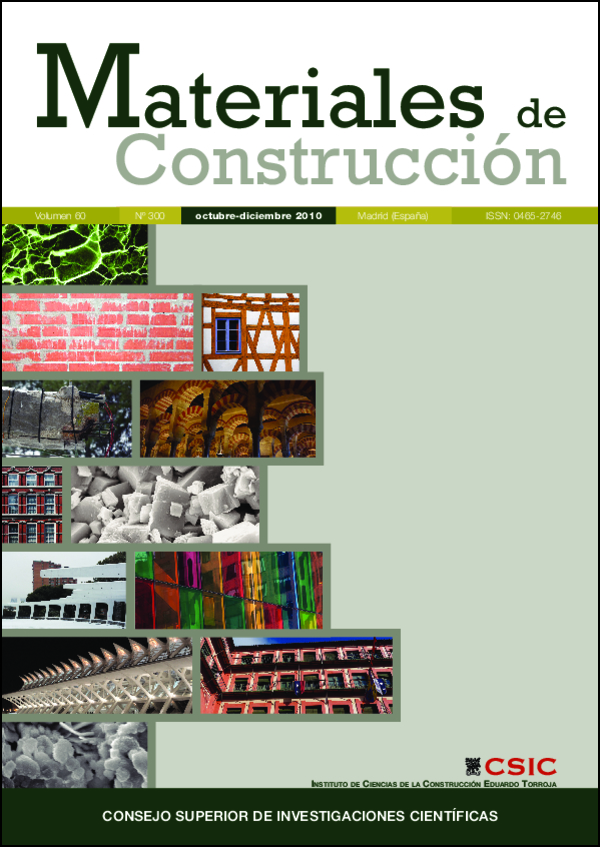A numerical-statistical approach to determining the representative elementary volume (REV) of cement paste for measuring diffusivity
DOI:
https://doi.org/10.3989/mc.2010.60810Keywords:
representative elementary volume (REV), cement paste, diffusivity, microstructure, HYMOSTRUC3DAbstract
Concrete diffusivity is a function of its microstructure on many scales, ranging from nanometres to millimetres. Multi-scale techniques are therefore needed to model this parameter. Representative elementary volume (REV), in conjunction with the homogenization principle, is one of the most common multi-scale approaches. This study aimed to establish a procedure for establishing the REV required to determine cement paste diffusivity based on a three-step, numerical-statistical approach. First, several series of 3D cement paste microstructures were generated with HYMOSTRUC3D, a cement hydration and microstructure model, for different volumes of cement paste and w/c ratios ranging from 0.30 to 0.60. Second, the finite element method was used to simulate the diffusion of tritiated water through these microstructures. Effective cement paste diffusivity values for different REVs were obtained by applying Fick’s law. Finally, statistical analysis was used to find the fluctuation in effective diffusivity with cement paste volume, from which the REV was then determined. The conclusion drawn was that the REV for measuring diffusivity in cement paste is 100x100x100 μm3.
Downloads
References
(1) Marchand, J.; Gerard, B.: “Microstructure-based models for predicting transport properties”, 2nd CANMET/ACI International symposium on Advanced in Concrete Technology, Las Vegas (1995).
(2) Chatterji, S.; Kawamura, M.: “A critical reappraisal of ion diffusion through cement based materials Part I: sample preparation, measurement technique and interpretation of results”, Cem. and Concr.e Res., 22 (1992), pp. 525-530. doi:10.1016/0008-8846(92)90002-D
(3) Bentz, D. P.; Jensen, O. M.; Coats, A. M.; Glasser, F. P.: “Influence of silica fume on diffusivity in cement-based materials I. experimental and computer modeling studies on cement pastes”, Cem,t and Concr. Res., 30 (2000), pp. 953-962.
(4) Garboczi, E. J., Bentz, D. P.: “Multi-scale analytical/numerical theory of the diffusivity of concrete”, Advn. Cem. Bas. Mat., 8 (1998), pp. 77-88. doi:10.1016/S1065-7355(98)00010-8
(5) Hashin, Z.: “Analysis of composite materials?a survey”, J. Appl. Mech., 50 (1983), pp. 481-505. doi:10.1115/1.3167081
(6) Bear, J.: Dynamics of fluids in porous media, Dover, New York, 1988.
(7) Xi, Y.: “Representative volumes of composite materials”, Journal of engineering mechanics, 12 (1996), pp. 1159-1167. doi:10.1061/(ASCE)0733-9399(1996)122:12(1159)
(8) Gitman, I. M.: “Representative volumes and multi-scale modeling of quasi-brittle materials”, Ph.D. Thesis, Delft University of Technology, Delft (2006).
(9) Nordahl, K.; Ringrose, P. S.: “Indentifying the representative elementary volume for permeability in heterolithic deposits using numerical rock models”, Math. Geosci, 40 (2008), pp. 753-771. doi:10.1007/s11004-008-9182-4
(10) Bear, J.: Dynamics of fluids in porous media, Americal Elsevier, New York (1972).
(11) Van Breugel, K.: “Simulation of hydration and formation of structure in hardening cement-based materials”, Ph.D. Thesis, Delft University of Technology, Delft (1991).
(12) Koenders, E. A. B.: “Simulation of volume changes in hardening cement-based materials”, Ph.D. Thesis, Delft University of Technology, Delft (1997).
(13) Ye, G.: “Experimental study & numerical simulation of the development of the microstructure and permeability of cementitious materials”, Ph.D. Thesis, Delft University of Technology, Delft (2003).
(14) Mills, R.: “Self-diffusion in normal and heavy water in the range 1-45 degree”, The Journal of Physical Chemistry, 5 (1973), pp. 685-688. doi:10.1021/j100624a025
(15) Garboczi, E.; Bentz, D.: “Computer Simulation of the Diffusivity of Cement Based Materials”. Journal of Material Sciences, 27 (1992), pp. 2083-2092. doi:10.1007/BF01117921
(16) Christensen, R. M.: “Mechanics of Composite Materials”. Wiley Interscience, New York (1979).
(17) Jennings, H. M.: “Colloid model of C-S-H and implications to the problem of creep and shrinkage”, Materials and Structures, 37 (2004), pp. 59-69. doi:10.1007/BF02481627
(18) Zhang, M. Z; Ye, G; van Breugel, K.: “Microstructure-based modelling of water diffusivity in cement paste”, Construction and Building Materials (accepted).
Downloads
Published
How to Cite
Issue
Section
License
Copyright (c) 2010 Consejo Superior de Investigaciones Científicas (CSIC)

This work is licensed under a Creative Commons Attribution 4.0 International License.
© CSIC. Manuscripts published in both the printed and online versions of this Journal are the property of Consejo Superior de Investigaciones Científicas, and quoting this source is a requirement for any partial or full reproduction.All contents of this electronic edition, except where otherwise noted, are distributed under a “Creative Commons Attribution 4.0 International” (CC BY 4.0) License. You may read here the basic information and the legal text of the license. The indication of the CC BY 4.0 License must be expressly stated in this way when necessary.
Self-archiving in repositories, personal webpages or similar, of any version other than the published by the Editor, is not allowed.


















